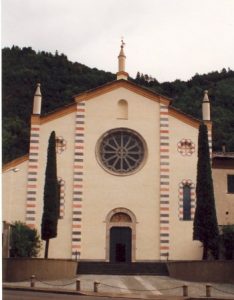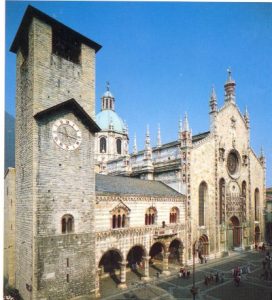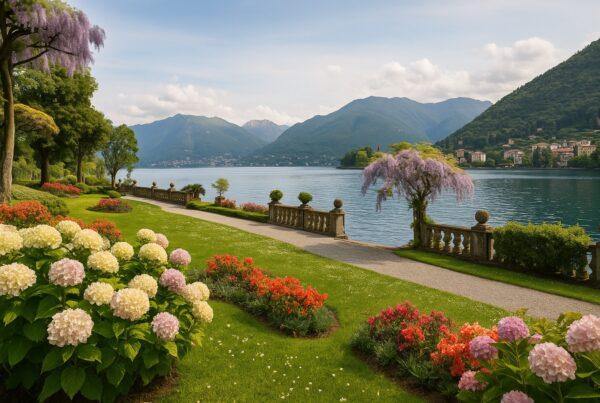GOTHIC and BAROQUE STYLE
ITINERARY: S.Agostino – Broletto – Duomo
 At the beginning of “Via per Torno” is located the church of S.Agostino. The church (14th century), is the only example of ogival Cistercian church in Como. After having been enlarged and embellished in the 17th and 18th centuries, it was modified in 1.773 and restored completely in 1.957. The spired facade contans a rosette, the portal and several windows; in the lunette, you can see a fresco made in the 16th century. Its interior features a nave and two aisles, a triumphal arch preceeding the presbitery, characterized by wooden beams covering the central nave and ribbed vaults above the lateral aisles.
At the beginning of “Via per Torno” is located the church of S.Agostino. The church (14th century), is the only example of ogival Cistercian church in Como. After having been enlarged and embellished in the 17th and 18th centuries, it was modified in 1.773 and restored completely in 1.957. The spired facade contans a rosette, the portal and several windows; in the lunette, you can see a fresco made in the 16th century. Its interior features a nave and two aisles, a triumphal arch preceeding the presbitery, characterized by wooden beams covering the central nave and ribbed vaults above the lateral aisles.
Painting by Recchis, D. Crespi and Morazzone can be seen together with frescoes of the 14th and 15th centuries. In the adjacent cloister there is a 15th century fresco.
Proceeding to the center of the city, you arrive in the square of the cathedral where it’ possible to visit two important monuments: The “Duomo and Broletto”. Broletto was erected in 1.215, flanked by the Civic Tower which was rebuilt in rusticated stone in 1.927, this building has a Gothic façade made in polychrome marble and dating from the 15th century, when its southern side was destroyed to make room for the Cathedral, which was then being enlarged. Originally intended as the headquarters of the local council, it was subsequently used as a theatre, a record office and, lastly, as an exhibition hall.
The Cathedral is the most important religious monument in Como, the emphasis of our walking tour shifts from the Middle Ages to the Renaissance. As a matter of fact, these two ages are reflected in this structure, whose construction started in 1.396 and was finished only three centuries later.
First of all the nave and the two aisles were built, starting from the transept; then it was the tum of the Gothic facade – featuring spires and Rodari’s statues – of the Renaissance flanks and of the apses; finally the dome was erected. This latter dates from the 18th century and was designed by Filippo Juvara. The interior is in the shape of a Latin cross. It has a nave and two aisles broken up by ten cruciate columns.
The Duomo has, also, numerous stone-works and paintings. The quite remarkable side-portals were engraved by the “Maestri Cumacini”. On the sides of the main portal, you will see the statues of Pliny the Elder and Pliny the Younger, by Rodari.
They provide a quite exceptional example of the veneration for two heathen figures in a temple of Christianity and symbolize an historic continuity from Roman times to the subsequent ages. Since the construction of the Cathedral, virtually absorbed the whole labor force in Como, the building of other structures was greatly reduced.
One of these structures deserves mention: the Hermitage of San Donato, located on the hill of the same name, half way between Como and Brunate. Founded by the Benedectine monks, it features a wooden altar dating from the 16th century.
The central part of the old Sant’Anna Hospital, in the shape of a cross and located at the corner of Via Cadorna and Via Cattaneo, also dates from the 15th century and was enlarged during the 16th, 17th and 18th centuries. This building has been meticulously restored and now houses the local Conservatoire.
Its restoration has unearthed brickworks, showing the history of the building. There are not other buildings of great artistic value, dating from the 14th century, a part from some religious buildings, which today have gone lost, such as San Donato church and some town-houses. Como has numerous 16th century monuments. At the end of that century, the Church of San Giacomo (11th century), located near the Cathedral, was completely restored, modified and reduced in size; the Church of Crocifisso was also built in that century but its facade, by Luigi Canonica, dates from the late 17th century. The Churches of San Donnino and of Jesus were restored.
The Church of Jesus is of ancient origin. It used to have two aisles. Now there is only one. Its interior dates from the 17th and 18th centuries. Also the Church of Sant’ Eusebio was rebuilt at the end of the 15th century on the ruins of a fifth century temple. As far as civic buildings are concerned, the most important are: the Gallio Boarding School (1.583); the Natta Palace, attributed to Pellegrino Tibaldi (late 16th century, with the little cloister of Santa Eufemia in its back garden; entry through Via Indipendenza); the Rusca Palace, dating from the 14th century and located in Via Rusconi, and finally the Odescalchi-Pedraglio Palace (1.587) in Via Rodari; Torriani Palace, which is at present seat of the Prefettura, and finally the so called Duca Palace in Mazzini Square.





